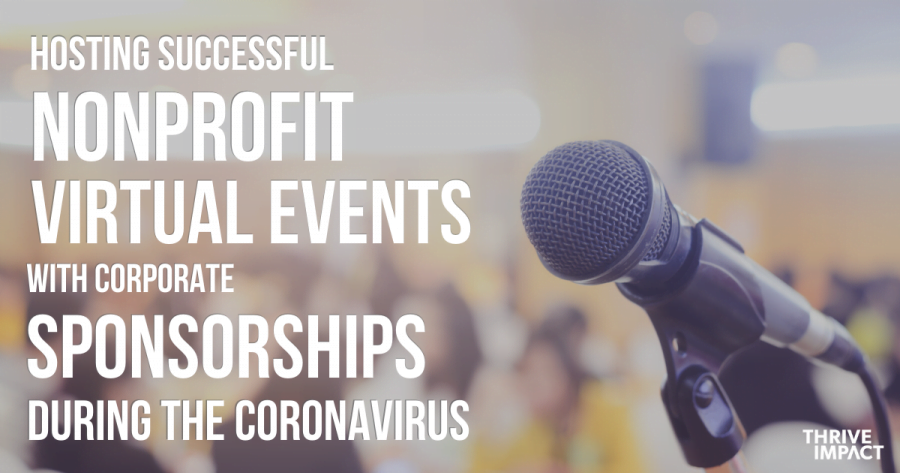
Start from a clean slate. It’s not enough to simply try to replicate an in-person event in an online environment. Invest the time and energy into planning a new online engagement that you would with an in-person event. Think about how to truly transform the event into a meaningful experience in a virtual way, which by nature has quite different connection points than in person. This is also a good time to expand your network and outreach beyond local geographical boundaries — an online event can attract more people regionally, nationally, and even internationally if the ask and event is thoughtful and engaging enough.
Meanwhile, the pandemic has been a real wake-up call for nonprofits and has forced leaders everywhere to reexamine priorities — which is challenging, but also presents a significant opportunity. It might be time to let go of the “one big event a year” crutch as the main pillar of your fundraising and development strategy. It can feel tired and rote to do the same thing year after year, and this crisis has shown just how vulnerable relying on one main source of revenue can be. Use this opportunity to radically reimagine, transform, and diversify your funding sources.
Engage them directly! Start with the people you know best, like your biggest supporters. Set up one-on-one meetings or small group sessions. Remember that your online strategy doesn’t only involve large-scale funding events. Use creative ideas and tech platforms to get people engaged and excited: Host small group calls on Zoom. Invite a special guest to share and participate on Google Hangouts. Set up town halls on Skype. Hold fireside chats on YouTube. Livestream concerts on Facebook Live. The point is that there are lots of options; jump in, try them out, and discover what works best for your audience! Note that with any platform you choose, make sure that it’s easy for participants to join and use, and be sure to test it out with a dry run before you go live.
Overall, a virtual event is fundamentally a tool to engage people and spark a conversation. It’s most successful is when the conversation (and ask) happens before, during, and especially after the event itself. Find ways to continue the conversation and keep it vibrant when the event is over.
High production value is essential. In these times, we’re on Zoom calls all day. So your events need to stand out to differentiate them from our regular meetings. If you’re hosting an event where people expect a high level of content, people will also expect higher production value. Your quality of content, production, engagement, and participation need to be leveled up to compete in a virtual environment that everyone has now become accustomed to.
If you’re holding small-scale events like living room interviews, casual Q&A, and informal panels or roundtables, then immediacy becomes the most compelling aspect of the engagement. Above all, be authentic and use audience availability to your advantage to make the conversation feel intimate. This also allows for lower production values to an extent. Set up breakout rooms from the main session to connect participants one-to-one and in small groups. Facebook Live, YouTube, Zoom, and other popular apps work well because you’re going where people already are and using the platforms they’re already familiar with.
Many corporate sponsors are shifting their priorities. Get personal. Connect their priorities specifically with your events and mission. Make sure there’s a close connection between your organizations. Bring them into the conversation — not only as a sponsor (give/get relationship), but as a supporter (give/give). Consider them a participant too! Invite them to be a part of the planning process for your events or fundraisers, so they can add real value. The old “sponsor packages” model has become obsolete; don’t simply offer them an opportunity to put their logo on your event, because that’s not enough anymore.
Practice radical empathy: Find out what their needs are right now, what they want, and how can you help fulfill their business goals… and of course how can they support yours, too. To attract new sponsors, rely on your network to make connections for you. Don’t be afraid to ask around. If current sponsors can’t give anymore or decide to reduce or shift their donation, ask them instead to connect you with their contacts at like-minded organizations. Finally, don’t disengage with a sponsor just because they don’t or can’t support you financially anymore. Keep them in the loop and stay engaged on a personal level. When the time is right for them to give again, they’ll remember you.
Here’s a hard pill to swallow: You simply might not be able to plan that far ahead right now. It sounds like a non-answer, but there are just too many unknowns right now. Invitations to in-person events may seem very tone-deaf during the pandemic. It is possible that we won’t be able to convene large gatherings even when social distancing starts again. And when state and federal restrictions are finally relaxed, individuals may not feel comfortable attending for a long time.
Right now, it’s best to focus planning on a few weeks or a month or two at a time. Keep an eye on scientific developments and be conservative in forward-planning in-person events.
To make up for the revenue gap, get creative and expansive with virtual fundraising. Diversify your revenue sources and strategies. Be dynamic, be flexible, and be resilient. Don’t be afraid to ask for help.


